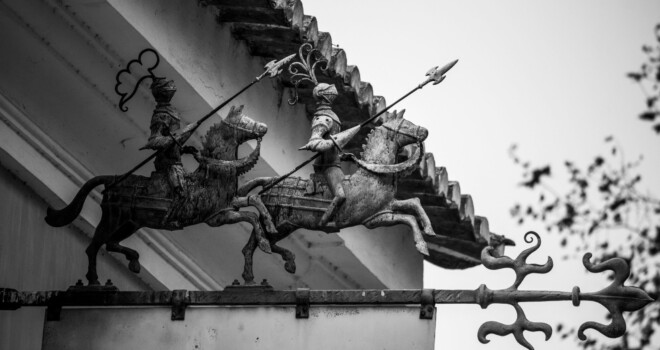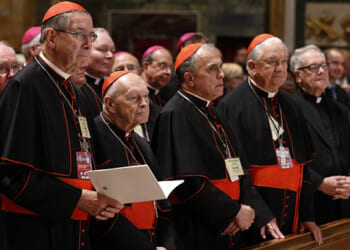In the new-ish Barbie movie, Ken gets very caught up in a macho-masculine movement which seems to exalt men and allow them to drink beer and hang out all day—he gets involved in “patriarchy.” Included in this patriarchy is an obsession with horses. Horse décor covers Ken’s Mojo Dojo Casa House. Eventually, Ken abandons patriarchy and says that he lost interest in it when he realized it wasn’t actually about horses. While patriarchy certainly isn’t about horses, and certainly isn’t what is portrayed in the Barbie movie, an alternative and ancient vision of masculinity is about horses and is named for them. It is, of course, chivalry.
Chivalry comes from the French word for “horse,” cheval, and the Latin word caballus. Caballus referred to a working horse that a mounted soldier might use to carry his gear; it was not the war-horse. Chivalry referred first to heavy cavalry. It was a military term. Cavalry was an expensive business. Contrary to what we see in the movies, heavy cavalry often used multiple horses. They had a pack animal to carry their heavy armor and supplies, and a different war-horse which was used exclusively in battle, in optimal conditions at least. Each soldier had to provide their own weaponry. Thus, only the rich would truly be knights simply due to cost.
While this may seem extremely un-patriotic to modern American ears, soldiers do not have the best reputation historically. Put a bunch of strong young men together in a group designed to fight, and you often don’t have a particularly moral group. Soldiers are usually, at best, a rowdy bunch, if not outright bullies. The common assessment of American soldiers during World War II by the British was that they were “oversexed.” Chivalry expanded from a purely military cavalry term to include a moral code given to these elite soldiers in an effort to civilize them.
The medieval Church turned to the idea of knighthood. The knight was a type of mounted heavy cavalry soldier, the elite warrior. In order to be a knight, a vow had to be taken. This vow included certain Christian moral norms. This vow, and keeping it, dignified the knight and improved their social reputation. It also helped transform these soldiers into good moral men who used their specialized skills to help others, to fight for good causes. The term remained tied to horses. A knight fought from horseback. The nobility and dignity of the knight required a horse.
Chesterton points out that man has never been so fine and noble as when he rides a horse. When discussing chivalry he says, “For the horse has really been lifted up along with the man in the wildest fashion in the very word we use when we speak ‘chivalry.’ The very name of the horse has been given to the highest mood and moment of the man” (Chesterton, The Everlasting Man, “Introduction”). The highest mood and moment of man is the chivalrous man, the man on the horse.
Chivalry, as an ideal of masculinity, combines several things. First, there is the undeniable martial element. The chivalrous man can fight. He is a warrior. He has the strength, skill, and courage needed for battle. This aspect of masculinity is often overlooked or mocked in the modern age, even, or especially, by Christians. War is truly the result of sin. But given that we inhabit a fallen world where sin cannot be finally overcome until Christ comes again, there will always be war, like there will always be poverty (Matt. 26:11). This is not a celebration of war; war is terrible. But sometimes war is the just and proper response, an obligatory response, to great evils in the world. The Catholic tradition has never embraced pacifism. But war is the realm of males. Men, as the physically stronger sex (1 Pet. 3:7), and the ones less needed in the home and by children (Prov. 31), are the obvious choice to be the soldiers in a just war. Men’s physiology is better for war as well. Male eyes are better than female eyes at tracking moving objects, men can identify the location of a sound better than women, men are better at 3D reasoning or object manipulation (helps them use tools, weapons, etc.), and the significantly greater amount of testosterone in males helps them be more aggressive than women.
Chivalry secondly includes the mastery and use of tools. Chiefly this is the horse for which chivalry is named. The use of tools is pertinent to masculinity because, while the feminine genius as described by St. John Paul II is a certain focus on and respect for persons, the masculine genius involves a focus on objects. Baby boys prefer mechanical toys while baby girls prefer personal toys. Eve’s first experience after her creation was a person, Adam, rejoicing in her (Gen. 2:22-23), while Adam’s first experience was with stuff, with non-personal things. Females typically have better lingual skills, but males usually have better skills with tools.
Thirdly, chivalry has a moral code. This is essential to it. It makes it respectable and good. One might be a rather masculine male, with much bravado and skills and success, but a bad, immoral person. Examples abound in cinema and real life. Yet men need a strong moral code in order to use their masculine strengths and gifts well, for the service of others. This is what sharply distinguishes chivalry from Ken’s absurd patriarchy. Men without manners, without morals, give patriarchy a bad name.
Fourth, chivalry was a social reality. To be a knight, to be chivalrous, was to be respected and admired by others. Men, more so than women, need to be affirmed by peers concerning their identity as a man. In a way, masculinity is more of a social construct than femininity is. By this we mean that a woman’s unique contribution to society is rather evident and undeniable. Only a woman can be a mother, and mothers are absolutely indispensable in family life. The mother’s femininity cannot be denied. Yet, a father’s masculinity can be.
The unique contribution of men to society and family life is harder to identify. Men are more replaceable than women, so to speak. Thus, in order to be secure in our masculine identities, men have often created certain criteria which provide an objective measurement for our masculinity. These often included coming-of-age rituals and challenges, or certain skills to be developed or goals to be attained. The affirmation of other men, of our peers and leaders, is essential to men for their masculine identities. Women need these things too, but not as intensely as men. Chivalry provides this.
Traditional ideas of chivalry dignify men. The use of the horse does ennoble the man. While patriarchy now has many absurd connotations which render it practically a useless concept or ideal for masculinity (one would need to spend too much time making qualifications), chivalry remains a classical and Christian notion of masculinity in stark contrast to the confusion of the age. And, it is about horses.
Photo by Wendell Adriel on Unsplash
















